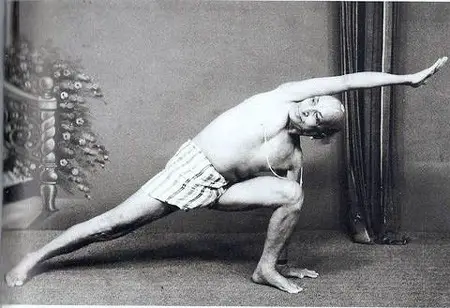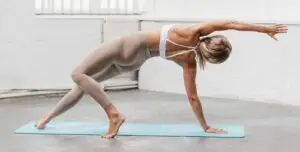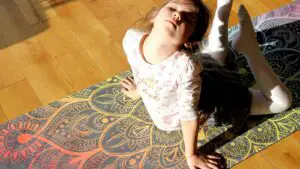Today, you can find Power Yoga, Hot Yoga, Ashtanga Yoga, Kundalini Yoga, Yin Yoga, and many more from which to choose. Most likely you practice one of these styles of yoga as well, but have you asked yourself the questions:
Where did yoga originate?
History of yoga? Do I know it?
How old is yoga?
Learning about the origin of yoga will only help you to deepen your yoga practice and appreciate more this spiritual tradition after knowing how long has yoga been around.
History of Yoga
The Pre-Classical Era of Yoga
There are four historical eras of Yoga that will help us track Yoga timeline. The first is the Pre-Classical Era.
Yoga originated 5,000 years ago in the northern region of India. Long before yoga was a moving practice with downward facing dogs and tree poses, yoga was an oral philosophy. The basis of yoga philosophy, taught by the Vedic priests, was to teach self-knowledge and internal wisdom. The historical Vedic religion, which probably dates as far back as 1500 BC, was the practice and belief of the time. It’s declarations were eventually written in the now classic Upanishads that includes well over 200 scriptures for study. The most famous of these ancient scriptures is called The Bhaghavad Gita which you can find and read today.
The Classical Era of Yoga

The Bhaghavad Gita wasn’t the only text with these written lessons. In fact, there were many. And because there were so many additional writings about the ideas of yoga, the teachings often became conflicted and contradictory. Things needed to be more organized – have some order – so that clear messages could be passed along.
Patanjali is not an inventor of yoga
Patanjali is known as the “father of yoga,” who offered a re-interpretation of yoga in an organized, written fashion. Patanjali wrote the Yoga Sutras, a collection of 196 Indian verses that displayed a theory and practice of yoga. Basically, the author took the notions of old and compiled them into a “modern” text so that yoga could have a consistent message to its students. He organized a set of practices which he called “the eight limbs.” These limbs were a pathway toward self-knowledge and enlightenment.
Yogigo suggests Patanjali yoga sutras book and DVD for your library
The Post-Classical Era of Yoga
Now that there was a consolidated reference of yoga in the Patanjali Yoga Sutras, yogis could continue their traditional studies, but with all things, a new change was on the horizon. In the Post-Classical Era, a radical set of people emerged declaring that there was a more comprehensive way to reach enlightenment. It was not solely dependent on the mental efforts of study that led people toward greater understanding and awareness. Up until this point, it was thought that enlightenment was something achieved from outside the body.
Tantra introduced the notion that the physical body is also a part of the journey. Cleansing the body to be pure and void of disease and distraction, so that the whole being, body, mind, and spirit, can reach enlightenment.
In a practice devoted to cleansing the mind and body, the yogi could see that the physical existence was connected and related to the non-physical realm, thereby a connection to enlightenment, to the Divine. The practice of Tantra Yoga developed in this era.
Tantra traditions have been thought to have been a foundation of many Indian religions including Hinduism and Buddhism. It incorporated a holistic approach for its practitioners that combined the ancient writings and rituals of yoga with a physical practice and meditation. In this era, we also see the practice of worshiping male and female deities and higher beings in addition to the study of the subtle and psychic body. These “new” ideas were a main part of the deeper study and practice of yoga that still exists even today.
The Modern Era of Yoga

As yoga continued to develop and evolve in the east, the Mind and Body yoga practice evolved into a form of Hatha Yoga. It was this style of yoga that eventually made its way to the western shores. T. Krishnamacharya (picture) is strongly responsible for bringing Hatha Yoga to the United States some time in the 1930’s. He had formed the first Hatha Yoga School in Mysore, India in the early 1920’s; it featured medicinal practices (Ayurveda) that coincided with the philosophy of yoga. He had several students who became highly influential in the continual teaching and modernization of yoga: B.K.S. Iyengar and Pattabhi Jois to name a few.
B.K.S Iyengar is known for customizing Hatha Yoga into a collection of 200 yoga poses accompanied by various styles of breath work to enhance healing in an individual. These components were designed to develop a strong, healthy mind, body, and spirit.
A particular feature of Iyengar’s style was introducing alignment and precision to the physical yoga practice
He also used props, like straps and blocks, to assist students in various poses. The intention was to build strength, mobility, and stability in the body. Is this all starting to sound familiar? Hatha Yoga is probably the most popular style of yoga practiced in the Western world. It was from these early teachings from people like Iyengar that introduced yoga all over the world.
It is also important to mention Pattabhi Jois. He also influenced the way we practice yoga in the west. He took some of the early teachings (remember the eight limbs from the Classical Era?) and formed a systematic style of yoga practice called Ashtanga yoga.
In Sanskrit Ashtanga means ‘eight limbs’
This school of thought and practice was developed sometime in the 1940’s and focused on strength, flexibility, and stamina. Although a highly physical and challenging form of yoga, it did not stray from the ancient traditions of the philosophy.
Yoga today
To conclude this background on yoga, a question you may still have is how did yoga become so popular? Although yoga was beginning to circulate outside of India by the 1930’s and ’40’s, it really did not make an impact until the 1950’s and ’60’s. It was during this time that the health and fitness industry was becoming the latest trend. People were flocking to newly opened gyms, fitness clubs, and recreation centers. Weight lifting and group aerobic exercise classes were coming onto the scene.
Hatha Yoga in it’s various styles, seemed to fit the mold of health and fitness that attracted people to these health centers. Yoga began to make its way into the local gyms and into stand-alone studios.
At first, yoga may have looked like a trend, but we can clearly see that yoga is something that is here to stay.
Now that you know brief history of yoga, the next blog post will help you to look at the various types of yoga that have emerged in our neighborhoods. We will examine the most popular ones and the best for you to practice. And to make it a little easier for you to decide, we will rank the styles from the easiest or least challenging to the most difficult or more challenging.





